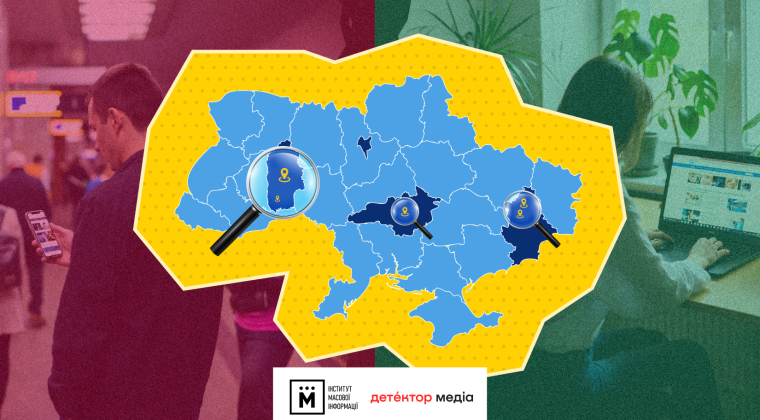84% of the most popular Ukrainian online media (42 out of 50) have listed their contact details on their websites this year. Last year, this figure was 76% of websites.
This is evidenced by the results of the survey on the transparency of the 50 most popular Ukrainian online media (according to SimilarWeb data), which was conducted by the Institute of Mass Information in late July – early August 2022.
IMI annually surveys the transparency of Ukrainian online media. The full-scale russian aggression affected the media as well, so their state was worth studying. This year’s methodology has been somewhat improved, as we have added new parameters to the study. However, the common research parameters for this year and last year can be compared.
The methodology. We monitored the 50 most popular online media (according to SimilarWeb data). The sample included the following media outlets: TSN, Ukrainska Pravda, Novoe Vremya, Censor, RBC-Ukraine, Channel 24, Liga, Espreso, Gordon, Focus, Korrespondent, UNIAN, Ohlyadach, Glavkom, Gazeta.UA, Apostrophe, Suspilne, Zakhid.net, Ukrainski Novyny, Ukrinform, Delo.UA, Radio Liberty, Telegraph, Novynarnia, Hromadske, UNN, Politeka, Livy Bereh, Slovo i Dilo, Znay, Dzerkalo Tyzhnia, Khvylia, Komentari, Interfax-Ukraine, KP in Ukraine, Novyny.Live, Vesti, Bukvy, Babel, Fakty newspaper’s website, Bahnet, Ekonomichni Novyny, the Ukrainian service of the BBC, Antikor, ICTV, Podrobytsi, Rakurs, Priamy, Holos.UA, and Channel 5.
The list of the 50 most popular websites surveyed has changed by 10% compared to the previous year: five media outlets have dropped out (due to closing down or a traffic drop), and five others that are currently popular in terms of clicks have been added instead. That is, the list of the surveyed online media has not changed significantly if we take this year’s wartime realities into account.
The survey checked the availability of the following information on the websites: 1) postal address of the media’s editorial office; 2) editorial email addresses; 3) emails of the editor-in-chief or their deputies; 4) emails of department editors; 5) editorial phone number; 6) feedback forms on the website; 7) links to the media outlet’s pages on social networks; 8) the media outlet’s editorial policy being published on the website, and 9) details about its final beneficiary (owner). A separate parameter (which was not included in the calculation of the points sum) examined whether the websites had listed any information about a Patreon account or other means to support the editorial office financially.
In this text, we will talk about the part of the monitoring results that concerns contact details (postal address, phone number, email addresses of the editorial office, editor-in-chief and their deputies, heads of editorial departments, feedback form).
The postal address of the editorial office was listed on the websites of 34 online media, and two more media outlets did so in a problematic way: on the TSN website, you have to search the long text of one of the documents to find the address, and on the website of the Ukrainian BBC service you can only find the address of the London office, provided in English. The following online media listed the address adequately: Channel 5, Holos.UA, Priamy, Podrobytsi, ICTV, Antikor, Ekonomichni Novyny, Fakty newspaper’s website, Babel, Vesti, Interfax-Ukraine, Khvylia, Dzerkalo Tyzhnia, Znay, Slovo i Dlo, Livy Bereh, Politeka, Hromadske, Telegraph, Radio Liberty, Delo.UA, Ukrinform, Ukrainsky Novyny, Zakhid.Net, Suspilne, Apostrophe, Gazeta.UA, Glavkom, Ohlyadach, Focus, Liga, Channel 24, RBC-Ukraine, and NV.
The overall transparency rate in terms of postal address disclosure is 72%. Only stating the settlement without the street and the building number or providing a map without specifying the building did not count as listing the editorial address.
General editorial e-mail addresses were listed on the websites of 43 media (86% of all), as well as TSN (although it was difficult to find); that is, in almost all of the studied media outlets except for Babel, KP in Ukraine, UNN, Hazeta.UA, Glavkom, and Korrespondent.
38 media (76% of all surveyed media) provided the editorial contact number on their websites, i.e. all except Antikor, Bahnet, Bukvy, KP in Ukraine, Novyny.Live, Khvylia, UNN, Telegraph, Korrespondent, Censor, Ukrainska Pravda, and TSN. Also, the BBC phone number can only be found on the English-language website of the London office (and it is not the number of the Kyiv office).
Comparison with the previous year. If last year, 76% of the websites publicly provided the majority of contact details, this year it was as many as 84% (42 online media outlets). That is, in general, it can not be said that the war intimidated most of the leading online media and became an incentive for them to remove their contact details from their websites (although currently, only 2/3 of them indicate their postal address). Of the media outlets that were included in this percentage last year, we only recorded one that had removed almost all contacts from their website, leaving only a map of Kyiv without a clear indication of their address. Four more media outlets of the ones found transparent in terms of contacts previous year dropped out of the survey list, for example, media outlet Segodnya.
This year, we introduced additional research parameters, the monitoring of which produced the following results.
The email address of the editorial office’s head or their deputy was noted on the websites of: NV, Channel 24, Liga, Gordon, Korrespondent, Ohlyadach, Glavkom, Ukrainsky Novyny, Radio Liberty, Khvylia, KP in Ukraine, and Ekonomichni Novyny (a total of 12 media outlets). Hazeta.UA, instead of listing the editor-in-chief’s email address, provided the opportunity to send him a message via a feedback form. In total, these constitute 26% of all the surveyed media.
The following online media outlets listed the email addresses of the editorial office’s department heads: NV, Channel 24, Liga, Gordon, Korrespondent, Ohlyadach, Ukrainsky Novyny, Telegraph, KP in Ukraine, and Ekonomichni Novyny. In total, these are 10 media outlets, that is, 20% of those studied.
The following media outlets had a feedback form on their websites: Channel 24, UNIAN, Hazeta.UA, Zakhid.Net, Slovo i Dilo, Novyny.Live, Vesti, the Ukrainian BBC service, Antikor, ICTV, Racurs, and Priamy channel. In total, these are 12 media outlets, that is, 24% of those studied.
In the upcoming publications, we will talk about the other results of our online media transparency survey, namely about listing the names of the editor-in-chief (or other manager), the ultimate beneficiary, and posting the editorial policy.



